- Quick Read
- Deep Read ( 8 Min. )

Why is Christian Science in our name?
Our name is about honesty. The Monitor is owned by The Christian Science Church, and we’ve always been transparent about that.
The Church publishes the Monitor because it sees good journalism as vital to progress in the world. Since 1908, we’ve aimed “to injure no man, but to bless all mankind,” as our founder, Mary Baker Eddy, put it.
Here, you’ll find award-winning journalism not driven by commercial influences – a news organization that takes seriously its mission to uplift the world by seeking solutions and finding reasons for credible hope.
Explore values journalism About usIn Today’s Issue
- As NCAA and Olympics start paying athletes, what happens to the amateur ideal?
- Today’s news briefs
- Taiwan protesters meet China’s intimidation with defiance
- How history led three countries to recognize a Palestinian state
- West Bank village, proudly self-reliant, now faces wartime hostility
- Trust in US elections wavers. Why it’s still higher than you think.
- LeVar Burton soars in ‘Reading Rainbow’ documentary
Monitor Daily Podcast
- Follow us:
- Apple Podcasts
- Spotify
- RSS Feed
- Download
TODAY’S INTRO
192 steps of progress in Ukraine
 Howard LaFranchi
Howard LaFranchi
A year ago I chronicled a somewhat bracing visit to the famous but off-limits and barricaded Potemkin Steps here in Odesa, Ukraine. My fleeting glimpse was cut short by an overzealous soldier who demanded a review of my phone’s photos.
This visit, I am glad to say, all barriers (and overzealous guards) are gone. Visitors ascend and descend the 192 granite steps at will – taking selfies with Odesa’s signature stairway is no longer a punishable offense. It’s a small thing in the grand scheme of the war, maybe, but still a heartening picture (literally) of progress. Keep an eye out for my stories from this trip during the coming weeks.
Share this article
Link copied.

Help fund Monitor journalism for $11/ month
Already a subscriber? Login

Monitor journalism changes lives because we open that too-small box that most people think they live in. We believe news can and should expand a sense of identity and possibility beyond narrow conventional expectations.
Our work isn't possible without your support.
As NCAA and Olympics start paying athletes, what happens to the amateur ideal?
Is it fair, Olympians and NCAA athletes have said for years, that they are the only ones not profiting from the years they’ve spent honing their skills? That is now changing.
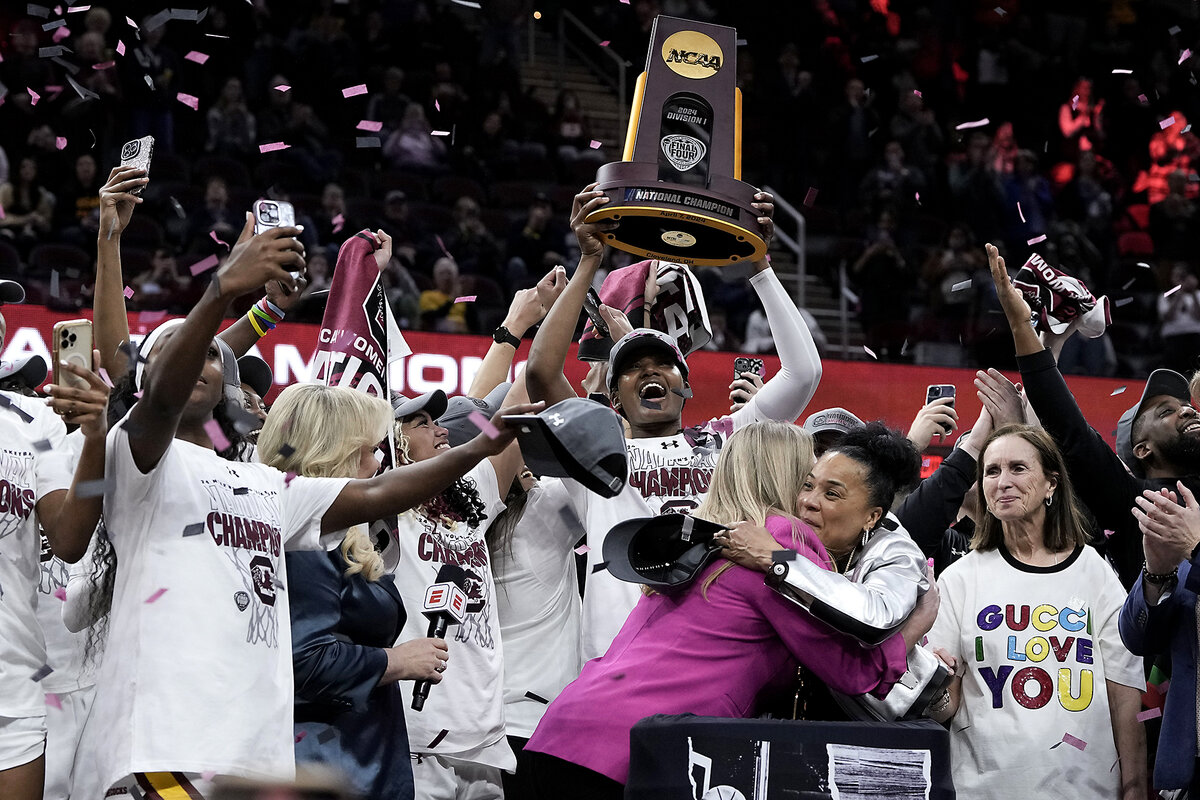
For the first time, U.S. track and field gold medalists will receive prize money at the Olympics. And on Thursday, the NCAA and college conferences agreed to start paying college athletes part of the profits generated from ticket sales, broadcast rights, and sponsorships. Current and former athletes who sued will receive $2.8 billion in damages.
What does that mean for the ideal of amateurism? Is the Olympic spirit lost if athletes are competing for money, rather than for solely the glory of representing their country?
The amateur ethos emerged from the wealthy 19th-century elite, who were the only ones who could benefit from it – and who specifically barred people who worked for a living from their sports clubs.
For his part, Matthew Robinson, a sport management professor at the University of Delaware’s Lerner College of Business and Economics, says, “The purist in me says no, but the reality of it is all the money being made. It’s the same thing that’s happening in college athletics.”
As NCAA and Olympics start paying athletes, what happens to the amateur ideal?
Day 6 of the 2023 Pan American Games in Santiago, Chile, was the day that Morelle McCane literally punched her ticket onto the USA Boxing Olympic Team roster.
One minute into her quarterfinal match, Ms. McCane split Costa Rican Nicole Vega Moya’s guard with a right uppercut, left cross combo that resulted in the first standing count knockdown. Thirty seconds later, a left cross ended the fight. Ms. McCane went on to win a silver medal.
Thirteen years after she started boxing in high school, she is one step closer to fulfilling her dream of winning Olympic gold. She has already won a slew of other medals, including four Golden Gloves, the 2023 Gee Bee International Tournament, and two USA Boxing Elite Championships. She trains twice a day, six days a week, a time-consuming effort. Yet she is still considered an amateur. In order for her mother and siblings to be able to come to Paris to watch her compete this summer, she started a GoFundMe page to raise $50,000. Currently, she’s well short of her goal.
If Ms. McCane were a track and field athlete, she would stand the chance of winning a $50,000 cash prize at the Olympics. World Athletics, the global governing body for track and field, announced in April that all track and field gold medalists will win prize money this year, and that relay teammates will split the same amount. The group also said it will start paying silver and bronze medalists in 2028. The possibility of this attitude spreading to the governing bodies of other sports, including less-celebrated Olympic competitions, caused curious inquiries and opinions from athletes about remuneration.
“The purist in me says no, but the reality of it is all the money being made. It’s the same thing that’s happening in college athletics,” says Matthew Robinson, a professor and area head of the sport management program at the University of Delaware’s Alfred Lerner College of Business and Economics.
Dr. Robinson helped the International Olympic Committee and United States Olympic and Paralympic Committee create the International Coaching Enrichment Certificate Program, which has provided coaching apprenticeships for more than 400 coaches in 125 countries in 24 different sports.
The Paris prize money comes amid a shift in thought about amateurism generally across the United States, especially in college athletics. The love of the game still exists, but there is a growing recognition that everyone else – from colleges to video game companies to broadcasters and betting operations – is making vast sums of money off the “amateurs.” Is it fair, these athletes and their supporters say, that they are the only ones not profiting from their own likenesses and the years they’ve spent honing their skills?
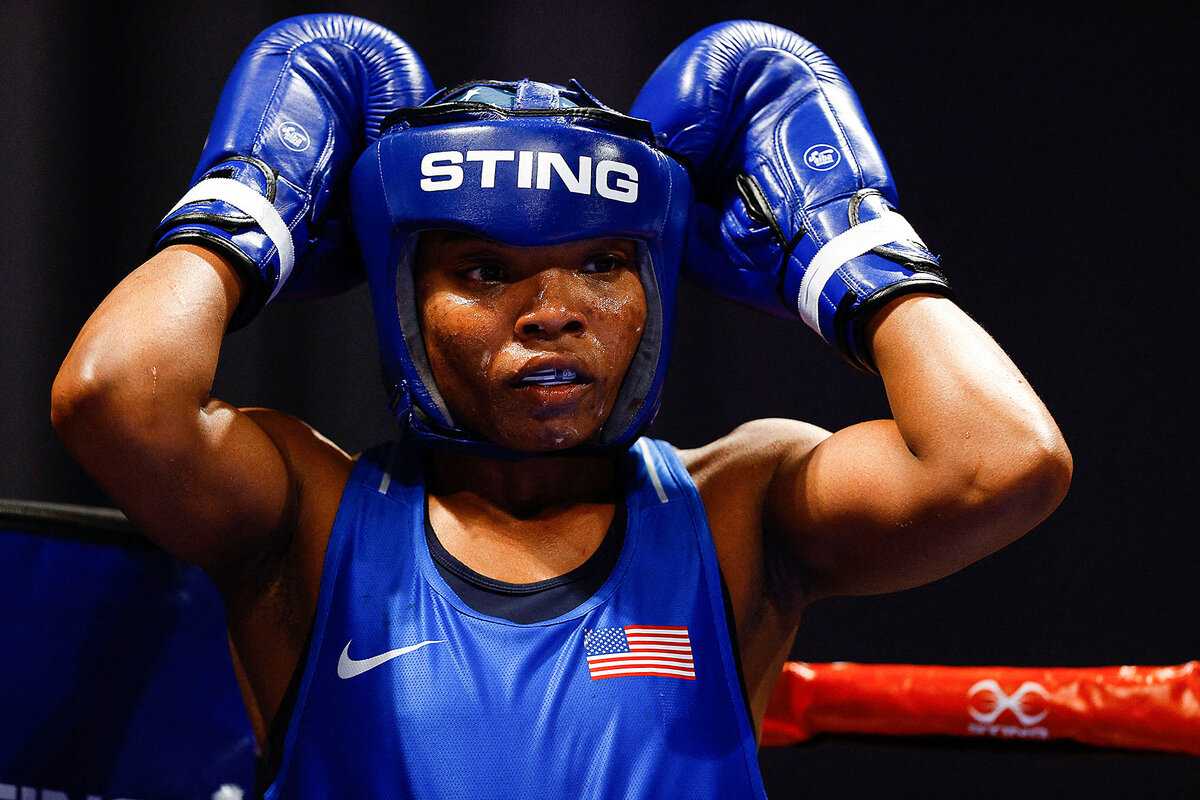
On Thursday, in a seismic change, the NCAA and college conferences agreed to start paying college athletes directly. Current and former athletes who sued in House v. NCAA will receive $2.8 billion in damages. The players sued arguing that it was their names, images, and likenesses that were being sold for broadcast rights. A new revenue-sharing model would pay athletes part of the profits their schools generate from sponsorships, ticket sales, broadcast rights, and other revenue streams.
On the other hand, is the Olympic spirit lost if athletes are competing for money, rather than for purely the glory of representing their country? For his part, Dr. Robinson says the Olympic ideal of amateurism has been eroded over time.
“The key is the embracing of the Olympic spirit for the athletes, that they are doing it for the love of sport,” Dr. Robinson says. He adds that a $50,000 reward for people like billionaire NBA star LeBron James, who will compete this summer, doesn’t move the needle. He understands how it could for others.
“There are a number of sports, where people have given up careers, because your peak years of being an elite athlete are also the formative years of starting a career ... and so the idea of compensation, sometimes you can say, ‘Hey, it makes sense,’” he says.
Ms. McCane is an example of someone who doesn’t get an off season.
“In a combat sport, it’s a year-round thing. You’re working six, seven days a week sometimes. In my sport, where you have to maintain weight, you have to do extra stuff sometimes. And people don’t see that side of it, but we know as athletes. ‘Show us the money,’” Ms. McCane laughs, quoting “Jerry Maguire” as she and other athletes speak about prize money at an Olympic summit in New York.
“That would definitely make us feel better, even though we already love the sport,” she adds.
From $0 to $737,000 to cash under the table
For the record, many countries pay winning athletes through their individual Olympic committees. The U.S. Olympic & Paralympic Committee (USOPC) pays winners $37,500 for gold, $22,500 for silver, and $15,000 for bronze. For the Tokyo Olympics, Singapore paid its gold medal winners the sum of $737,000. And, historians agree, in the past some Olympians were paid under the table.
The money that World Athletics is awarding athletes comes directly from a $2.4 million pot that it gets from the International Olympic Committee. As a nonprofit organization, World Athletics puts 90% of money earned back into sport and development. Not every participating athlete gets large sponsorship deals, and not everybody wins a medal. But all, the organization points out, add value to the competitions.
Requests for compensation go back more than a decade. In 2012, U.S. track and field gold medalist Sanya Richards-Ross suggested that track and field stars should be paid and allowed to wear uniforms with more than one sponsor’s logo. Dwyane Wade, Hall of Fame NBA champion and Olympic gold medalist, also suggested that he and fellow basketball Olympians should be paid for their time, the tickets and jerseys sold, and overall contributions.
“What makes the Olympics and Paralympics valuable are the athletes,” says Victoria Jackson, a sports historian and associate professor of history at Arizona State University. Several things are true about sport and the Olympics, Dr. Jackson says. First, the Olympics are a quadrennial event, which only temporarily gives some individual athletes a large platform to compete and show their prowess, despite needing to train and sacrifice in between those years.
“I just know the sacrifices that so many Olympic and Paralympic athletes make in so many sports. There are people living below the poverty line who are the best in the world at what they do who are really struggling or just leaving sport because they can’t afford to stay,” Dr. Jackson says.
Reimagining the Olympic model
One payout every four years likely wouldn’t help in the long run either. From an administrative perspective, the idea of compensating Olympians looks different.
Gene Sykes, chair of the USOPC, says international federations invest money in players how they see fit. “I think they do it thinking about, what is it that motivates the athletes to make the sacrifices to compete and continue to train and be in a position where they can do what they do?” Mr. Sykes says.
Mr. Sykes, a longtime Goldman Sachs executive, assumed his role as chair publicly urging his peers to reimagine the Olympic business model, with thoughts on adequate funding and growth. That reimagining means raising money for athletes through the U.S. Olympic and Paralympic Foundation. Mr. Sykes says identifying commercial partners and boosting philanthropy and partnerships to support athletes is key, and that the USOPC is quietly working to do that. The organization helps athletes via stipends, training costs, travel, and other forms of support.
“Our whole strategy is to identify the continuum of an athlete being developed, making the team, being on the team, being motivated to stay on the team, and committing themselves to performing with the team,” Mr. Sykes says. He adds that the USOPC is looking for ways to engage athletes after their playing days are over.
Lastly, Mr. Skyes says that athletes have the opportunity to take advantage of digital and social media to create a brand and reputation.
“In order to be an elite, successful athlete, you need access to facilities, coaching, training, correct diet, all of those things,” Dr. Robinson says, and he adds that the USOPC’s holistic view of supporting athletes does that.

Who can afford to be an amateur?
Prize money from World Athletics is a part of a mindset shift that officially happened in 1988, but was set in motion before that. Olympic organizers once staunchly held to the idea that those competing were amateurs, the same way college athletics viewed its players.
Olympic organizers strictly adhered to amateur rules and stripped American track and field star, Jim Thorpe, of the gold medals that he won at the 1912 Olympics. The reason? He once received money for playing a different sport, baseball. The legendary Native American athlete’s medals weren’t restored until 1982, long after his death – and long after many complained that the International Olympic Committee had not followed their own 30-day disqualification rule.
The ideal of amateurism was born amid bias, class, and racial segregation. In the 1800s, those who could take advantage of leisure pastimes were wealthy and mainly white. During the start of modern Olympics, the top 5% of the U.S. possessed 30% of the wealth, writes Steven Riess in his three-volume encyclopedia, “Sports in America From Colonial Times to the Twenty-First Century.”
Wealthy people had time and money to establish sporting clubs. Clubs like the New York Athletic Club, founded in 1866, offered athletic competition among a social class that shared values, customs, and lifestyles. They were highly selective in membership and participated in sports such as yachting, hunting, and polo. The club sponsored the first national track and field championships in 1876 and set standards for amateurism.
Other events, such as the Henley Royal Regatta, held in 1878, set limits on amateurism by saying, “No person shall be considered an amateur or sculler ... who is or has been by trade or employment for wages, a mechanic, artisan or laborer.”
Laborers simply didn’t have time to play sports, given that factory work came with low incomes. They lived in urban neighborhoods with few facilities. European migrants from Britain, Germany, and later Ireland gravitated toward boxing. Black Americans, mostly in the South, were segregated by law, and participated in sports via church, political, or fraternal organizations to promote a sense of community.
“It’s a silly thing, and it just makes me laugh,” Dr. Jackson says of the idea of amateurism as an ideal. Dr. Jackson says the nostalgia and purism never truly existed and could be more accurately understood as reflections of socioeconomic class.
“The originators of [the Olympics] all had titles, like lords and barons, and they had eight weeks to just go and play games with each other and declare each other gold medalists,” she argues.
After World War II, the Olympics were commercialized and then democratized, which led to more people without large amounts of wealth being able to participate. As far as amateur versus professional, Olympic basketball perhaps best illustrates how that worked when the first USA “Dream Team,” led by Michael Jordan, dominated competition in 1992.
The idea of amateurism has endured mostly in the U.S., held on to by organizations like the NCAA. Big money earned in college football helped push the movement forward via competitions, training facilities, stadiums, and quality of opponents, Dr. Jackson says.
“The point is that the only place people talk about amateur sports is in the United States,” she says. “This idea of amateur doesn’t exist anywhere else anymore, because when the Olympic movement abandoned it, everybody else did.”

Today’s news briefs
• Gaza aid route: Egypt and the United States agree to send humanitarian aid to the United Nations in Gaza via Israel’s Kerem Shalom crossing until legal mechanisms are established to reopen the Rafah border crossing from the Palestinian side.
• World court on Israel: Judges at the top United Nations court order Israel to halt its military assault on the southern Gaza city of Rafah, in a landmark emergency ruling in South Africa’s case that accuses Israel of genocide.
• North Korea spy satellite? South Korea’s military says it has detected signs that North Korea is preparing to launch its second military satellite into space.
• Remembering Srebrenica: The United Nations approves a resolution establishing July 11 as an annual day to commemorate the 1995 genocide of more than 8,000 Muslim Bosniaks by Bosnian Serbs.
• Remorse over protest response: The head of the University of California, Los Angeles tells a House panel that the school should have been ready to immediately remove an encampment of pro-Palestinian activists that became the site of a violent clash in April.

Taiwan protesters meet China’s intimidation with defiance
After Taiwan recently elected a pro-independence president, China launched aggressive military exercises. Now, pro-democracy protesters in Taiwan are responding with their own show of force.
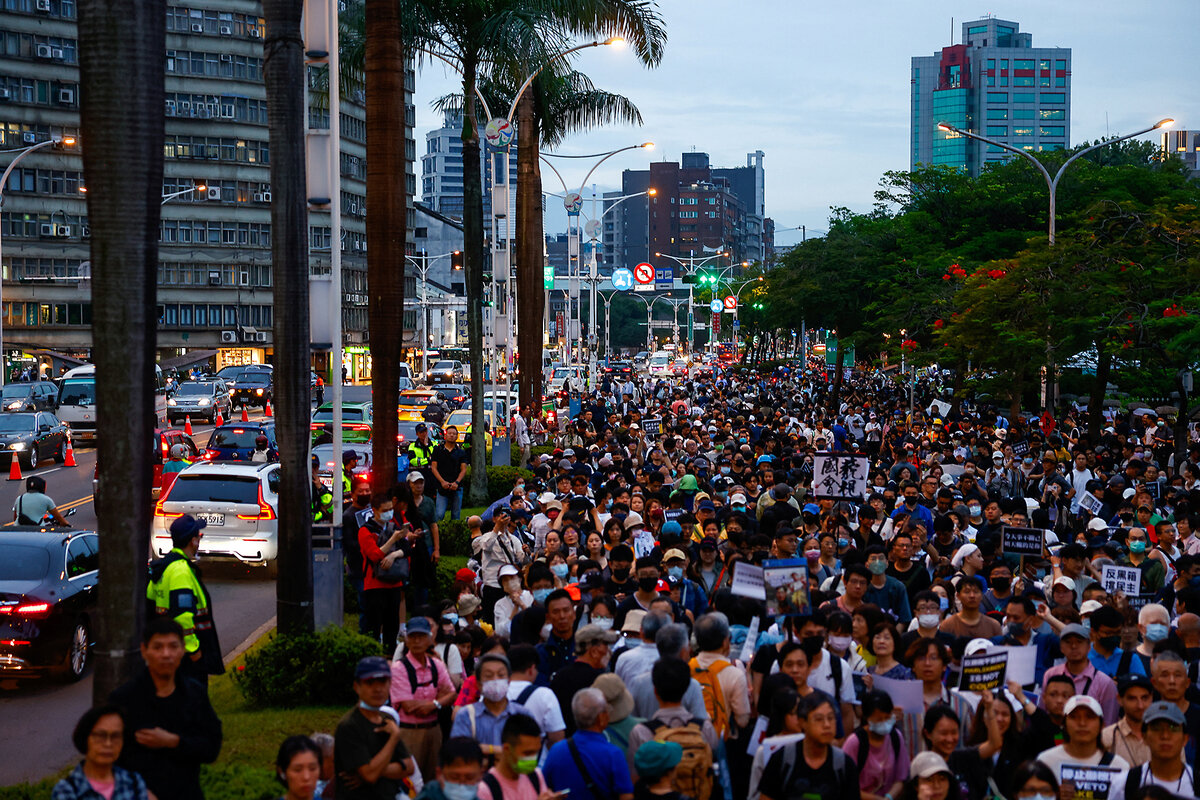
- Quick Read
- Deep Read ( 4 Min. )
Friday is the second day of Chinese military drills to the north, south, and east of Taiwan. China’s message: The People’s Liberation Army can conduct “political strikes” against Taiwan independence strongholds, while also blockading the island and choking off its exports, energy imports, and navy.
China considers Taiwan a renegade province and has vowed to bring the self-governing democratic island of 24 million people under Beijing’s control, by force, if necessary.
But the mass protests that erupted Friday were a different kind of political strike – one of defiance against the missiles and rhetoric pointed at the island. Taiwan’s new president, Lai Ching-te, who was sworn in Monday, has pledged to “neither yield nor provoke” China’s leaders.
The protesters stood with him, and against all efforts – within Taiwan and without – to undermine the island’s autonomy. “China has been threatening us for decades,” says one protester. “Of course I worry, but worry can’t save us. We need to learn to save ourselves.”
Taiwan protesters meet China’s intimidation with defiance
Mass protests erupted in Taiwan Friday in defiance of military and political pressure from Beijing, as China waged a large-scale military exercise aimed at testing its ability to forcibly control the island.
Tens of thousands of Taiwanese poured into the streets of Taipei on Friday chanting slogans against what protesters called anti-democratic, China-backed legislative reforms by the island’s Beijing-leaning political party.
“China has been threatening us for decades,” says Jenny Yeh, a self-described housewife from Taipei. “Of course I worry, but worry can’t save us. We need to learn to save ourselves.”
In a second day of “joint strike drills” targeting Taiwan, China on Friday dispatched scores of People’s Liberation Army (PLA) jets and bombers and more than a dozen naval and coast guard ships in what Beijing called a “warning” to the new administration of Taiwan President Lai Ching-te, who was sworn in Monday.
Beijing said the drills to the north, south, and east of Taiwan were aimed at demonstrating the PLA’s ability to conduct “political strikes” against Taiwan independence strongholds, while also blockading the island and choking off its exports, energy imports, and navy.
The PLA also launched mock missile strikes on Taiwan, and some of its jets reportedly carried live missiles. Taiwan scrambled jets and placed its armed forces on alert in response to the PLA drills.
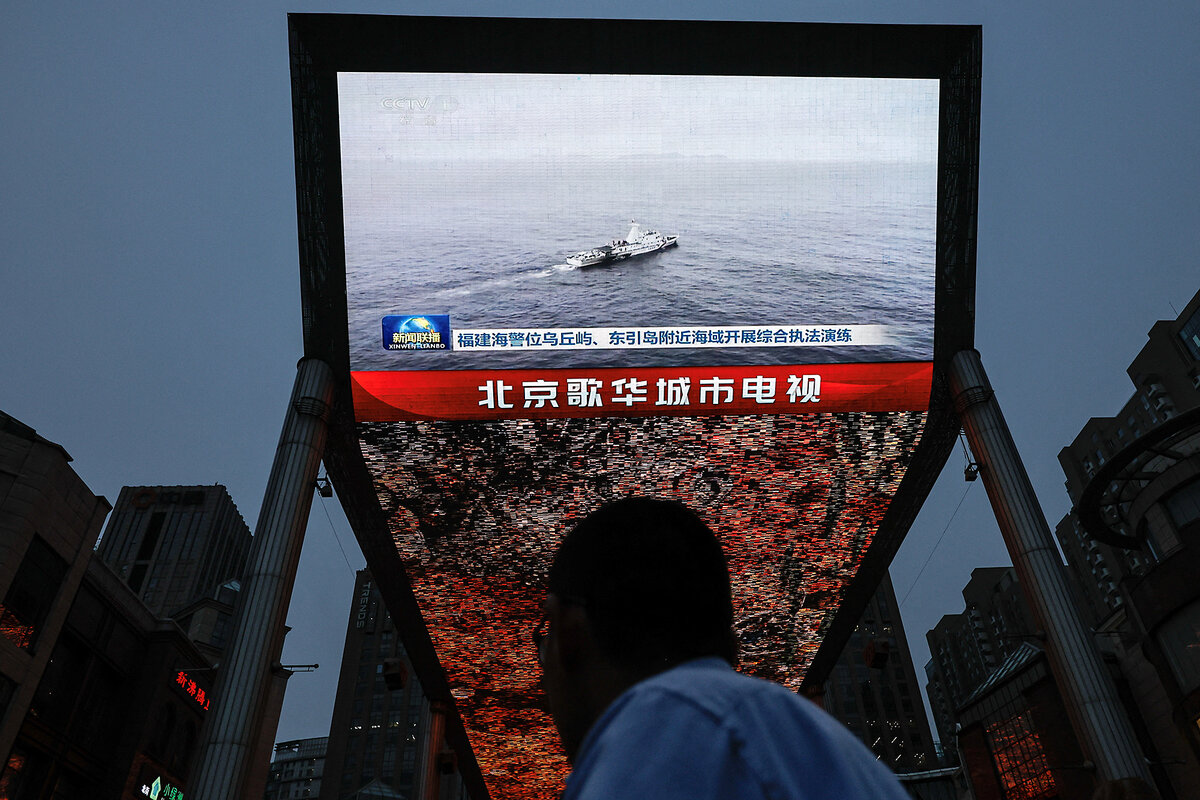
China considers Taiwan a renegade province and has vowed to bring the self-governing democratic island of 24 million people under Beijing’s control, by force, if necessary.
In his inauguration address on Monday, Dr. Lai called for China to end its military and political intimidation of Taiwan. He pledged to “neither yield nor provoke” China’s leaders, urging peace and proposing dialogue and exchanges with the mainland. In response, China’s Foreign Minister Wang Yi on Tuesday called Dr. Lai “despicable” and accused him of asserting “a more radical and adventurous stance on ‘Taiwan independence.’”
In electing Dr. Lai, Taiwan’s voters resisted blunt warnings from Beijing, which cast the January presidential election as a choice between war and peace. Dr. Lai’s victory gave his Democratic Progressive Party (DPP) an unprecedented third term. Polls show that Taiwan’s voters overwhelmingly prefer maintaining the status quo of the de-facto independent island’s relations with China.
Concern over China’s direct and indirect pressure tactics fueled the turnout of an estimated 100,000 protesters in Taipei on Friday to decry legislation put forth by the opposition Nationalist Party, or Kuomintang (KMT), which has historically supported Taiwan’s unification with China. Beijing backed the KMT presidential candidate Hou Yu-ih, who came in second, but whose party took the most seats in Taiwan’s parliament, the Legislative Yuan. (The KMT took 52 of the 113 total seats; the DPP took 51.)
Since the election, KMT legislators have been working aggressively to dismantle DPP policies. Together with a smaller opposition party, the Taiwan People’s Party, the KMT is seeking to speed through sweeping bills that would expand the power of the parliament and curtail Dr. Lai’s presidency.
The bills, if passed, could compel the head of state to report and undergo questioning by lawmakers, and also broaden the parliament’s investigative powers.
Protesters say the lack of proper deliberation over the controversial bills poses a threat to democracy.

“No debate means no democracy!” the crowd of demonstrators chanted as their numbers swelled on Friday afternoon.
From retirees fanning themselves in the heat to uniformed high-school students waving sunflowers and mothers with children in tow, the demonstrators condemned the KMT, saying its bills risk undermining Taiwan’s democracy and doing Beijing’s bidding.
“We are fighting for our democracy,” says Ms. Ko, a self-described full-time mother, shouting slogans in unison with a rally leader. She waves a sign in Chinese that reads “oppose the black box” – a reference to the KMT’s lack of transparency. “I am 100 percent sure that what the KMT is doing has to do with the CCP [Chinese Communist Party]” influence, she says.
Chung-chun Yang, a retired mathematics professor, agrees. “The KMT is doing what the CCP wants,” he says, referencing recent high-profile KMT delegations to China.
The ranks of protesters grew throughout the day, and people crowded the streets until midnight, when the legislative session adjourned for the day without the bills being passed.
“Today … tens of thousands … once again demonstrated the power of civil society,” Dr. Lai said late Friday on social media. “Together, we will defend Taiwan’s democratic values,” he said, urging the parliament to “allow different opinions to be fully discussed.”
People dispersed under a moonlit sky, with many saying they would return when the legislature resumes next week. “I come to help people protest,” says octogenarian and retired factory owner Yihung Lee, who came to Taipei from Kaohsiung City. “I will be back on Tuesday.”

How history led three countries to recognize a Palestinian state
The move by three European countries to recognize Palestinian statehood may not immediately facilitate diplomacy seeking lasting Mideast peace. But the nations maintain that it’s a matter of moral urgency.

- Quick Read
- Deep Read ( 5 Min. )
-
Sophie Hills Staff writer
Israel has grown increasingly isolated on the world stage over its war conduct in Gaza. And this week, pressure mounted.
On Friday, the International Court of Justice ordered Israel to “immediately halt” its offensive in Rafah. That follows the announcement earlier this week by the International Criminal Court’s chief prosecutor that he is applying for arrest warrants for three Hamas leaders as well as Israeli Prime Minister Benjamin Netanyahu and Defense Minister Yoav Gallant.
And breaking with most Western countries, Ireland, Norway, and Spain announced they will recognize Palestinian statehood next week.
That move is considered premature by the United States and most other European countries. They maintain that lasting peace between Israel and a Palestinian state requires a negotiated agreement first. But the three countries, which are driven by their own histories, are pushing against the diplomatic status quo. And more European countries are expected to follow.
“Now, there is the recognition that there is no peace process, and hope is almost gone,” says Jørgen Jensehaugen, a senior researcher at the Peace Research Institute in Oslo. “So we need to try something to revive hope.”
How history led three countries to recognize a Palestinian state

When three European countries formally recognize Palestinian statehood next week, little will change on the ground in Gaza. But for the governments of Ireland, Norway, and Spain, that’s not the point.
Precisely at a time when peace seems furthest away, the largely symbolic announcement stands as a desperate call to revive the two-state solution seen by most of the international community as paramount to future peace between Israel and a Palestinian state.
The move is considered premature by the United States and most other European countries. They maintain that lasting peace requires a negotiated agreement first. But the move by Ireland, Norway, and Spain − reflecting in part their own cultural and historic sensibilities − is part of growing condemnation of Israel for its war conduct in Gaza, and a matter of what they consider moral urgency.
“It is very likely that the war in Gaza will eventually be seen as one of the darkest episodes of the 21st century,” said Spanish Prime Minister Pedro Sánchez this week. “When that moment comes, I want the Spanish people to be able to say with their heads held high that they were on the right side of history.”
Breaking from most Western countries that demand a successful peace process in order to recognize a Palestinian state, Ireland, Norway, and Spain have “turned the logic around,” says Jørgen Jensehaugen, a senior researcher at the Peace Research Institute in Oslo. More European countries are expected to follow. “Now, there is the recognition that there is no peace process, and hope is almost gone,” he says. “So we need to try something to revive hope.”
It’s another blow to Israel, which has grown increasingly isolated on the world stage. On Friday, the International Court of Justice ordered Israel to “immediately halt” its offensive in Rafah in southern Gaza. That follows the announcement earlier this week by the International Criminal Court’s chief prosecutor that he is applying for arrest warrants for three Hamas leaders as well as Israeli Prime Minister Benjamin Netanyahu and Defense Minister Yoav Gallant.
Israel responded to the joint announcement by Ireland, Norway, and Spain by recalling its ambassadors from the three countries. Mr. Netanyahu called the move a “reward for terrorism.”
The three countries condemned Hamas’ brutal Oct. 7 attack on Israel that sparked the war, and they emphasized the importance of building a Palestinian state with the Palestinian Authority, not Hamas, which the U.S., the United Kingdom, and others consider a terrorist organization.
“Recognizing the state of Palestine sends a message that there’s a viable alternative to the nihilism of Hamas. Hamas has nothing to offer but pain and suffering to Israelis and Palestinians alike,” said Irish Prime Minister Simon Harris at a press conference this week.

A reflection of history
Ireland’s position, like that of Spain and Norway, is guided by history.
Ireland has long underscored its solidarity with independence based on its centurieslong experience of British occupation. That “direct and sustained experience of imperialism” has “undoubtedly shaped” how the Irish people view the Palestinian issue, says Jane Ohlmeyer, professor of modern history at Trinity College Dublin.
Norway has seen itself as an important player in international peace processes, and especially as a mediator of peace between Israel and Palestinians. It hosted the meetings leading up to the 1993 Oslo Accords, a framework that ultimately fell apart.
Spain, too, has historically built ties with the Arab world, including the Palestinians, dating back to post-World War II. Spain was barred from joining the United Nations because of former Spanish dictator Francisco Franco’s links to Nazi Germany, says Isaías Barreñada Bajo, professor of international relations at the Complutense University of Madrid, and instead turned to Latin America and the Arab world for diplomatic relations. Spain didn’t establish diplomatic relations with Israel until 1986, after joining the European Economic Community. (Over two dozen countries, primarily Arab nations, have never recognized Israel as a state.)
Today, Spain sees itself as uniquely positioned to play a peacemaking role in the region because of its geographic proximity and ties to both sides, says Dr. Barreñada.
While these three governments have been vocal in their support of Palestinian rights, “they’re also responding to publics who are [calling] for such steps,” says Hugh Lovatt, senior policy fellow at the European Council on Foreign Relations. Palestinian statehood was supported by 78% of those polled in a recent Spanish survey.
A growing recognition
With the vast majority of military support for Israel coming from the U.S. and Germany, the recognition is unlikely to affect the current course of the war, however. And some worry it could undermine their government’s ability to help broker a long-term peace solution.
“I would have liked such a sensitive decision to be taken only when there is a consensus built with precision and care” among the biggest global powers most involved in the conflict, says Diego Garrocho Salcedo, professor of moral philosophy at the Autonomous University of Madrid.
“All well-intentioned people want a just and lasting peace in the Middle East,” he adds. “Disagreement arises in the nuances about how, when, and through which actors we can achieve that.”
Still, the three acted amid a growing recognition of Palestinian statehood. Earlier this month, the United Nations General Assembly overwhelmingly backed a Palestinian bid for U.N. membership, a status that is only open to states. Around the world, 140 countries recognize a Palestinian state already; in Europe, that includes only Sweden and a handful of Eastern European countries.
The three-way announcement this week points to the power these countries see in numbers. It’s unlike Sweden’s unilateral recognition of Palestinian statehood in 2014, which had little impact. Slovenia, Belgium, and Malta have indicated they are considering similar announcements.
“The countries that sign up for this will carry more and more weight collectively,” says Linda Robinson, senior fellow at the Council for Foreign Relations in Washington. “We’re at a moment of moral crisis. ... People feel they have to be very clear on the morality of how this war is being conducted and what they can and can’t support.”

West Bank village, proudly self-reliant, now faces wartime hostility
Long before the war in Gaza erupted, Monitor reporters covering the West Bank found a remarkable story of self-sufficiency in Farkha, a village frustrated by inattentive local governance. The war has brought new threats, so our reporters returned.
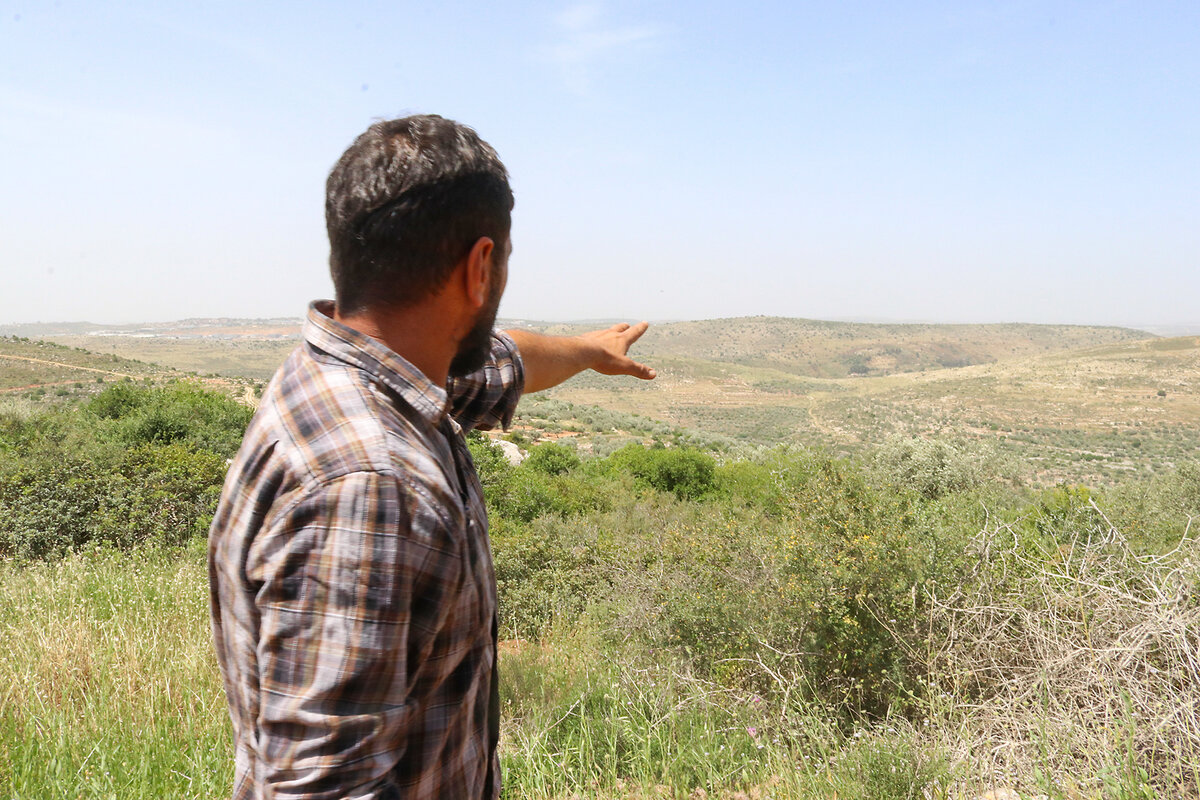
- Quick Read
- Deep Read ( 8 Min. )
-
Fatima AbdulKarim Special contributor
In the village of Farkha, the outbreak of the Israel-Hamas war, although a blow to the West Bank economy, initially bolstered residents’ buy-in to the self-sufficient communal farming model pushed by Mayor Mustafa Hammad. After Israel canceled their work permits, some 90 Farkha residents skeptical about farming picked up shovels and rakes and returned to their lands.
Farkha is faring better than most amid Israeli settler attacks and military road closures. Yet feel-good vibes mask a harsher reality: The village is under threat.
Settlers from a nearby hilltop outpost leveled dozens of acres of Farkha farmland last October to build new roads. Residents who watched Bedouin communities pushed off their farmlands fear they may be next.
But when Farkha sought Palestinian Authority funding last year for projects ranging from water to agriculture to infrastructure, it did not receive a single reply. There is an unshakable feeling here that the village is on its own.
“A village cannot stand up to an entire army and settler militias,” says farmer Maher Rizaqallah. “We need unity and support in order to endure.”
Gazing at the hilltop outpost, Mayor Hammad is defiant: “We will cling onto our land no matter what it takes.”
West Bank village, proudly self-reliant, now faces wartime hostility
While most villages across the beleaguered West Bank lie dormant, Farkha buzzes with activity.
Farmers plant summer vegetables and wheat, blacksmiths weld iron gates, women prepare jarred pickles and jams for sale, and dozens gather in the recently opened cafe.
This Palestinian village, which a year and a half ago was found to be witnessing a revival built on self-sufficiency and an everyone-pitches-in philosophy, is faring better than most amid Israeli settler attacks, military road closures, and a suffocated economy.
Yet the feel-good vibes and flurry of activity mask a harsher reality: Farkha is under threat.
While its indigenous concept of Al Ouneh – collective philanthropy and communal farming – is keeping it afloat, residents say that this is not enough to shield the village from the closures and a legion of armed and organized far-right settlers.
Residents say that in a war, it takes more than a village.
“We are better off than other towns and villages,” says home-garden farmer Maher Rizaqallah, “but we can’t survive alone.”
A call to farms
The outbreak of the Israel-Hamas war, although a blow to the West Bank economy, initially bolstered villagers’ buy-in to the communal farming model pushed by Mayor Mustafa Hammad.
When Israel canceled work permits for West Bank workers, some 90 Farkha residents who worked in Israel and were skeptical about farming began picking up shovels, hoes, and rakes and returned to their families’ lands.
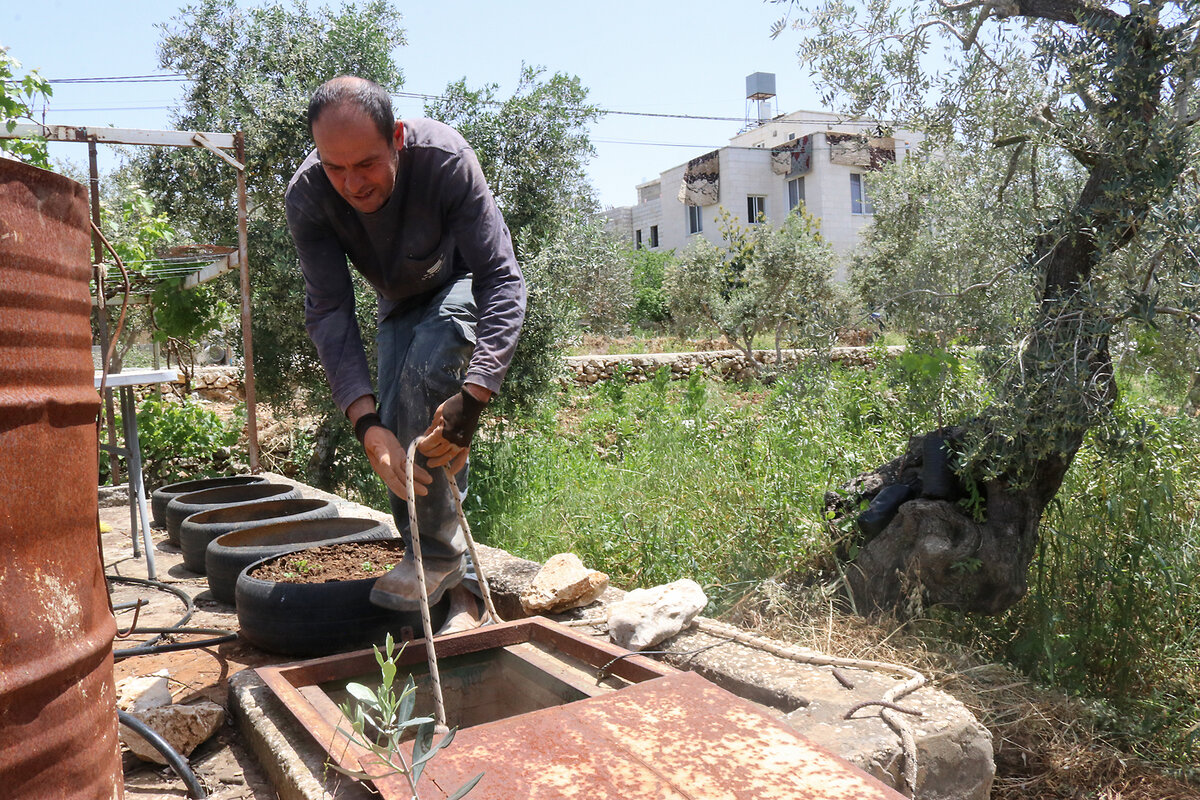
Riad Damdoom and his nephew Khalil, both of whom worked in construction in Israel until Oct. 7, are clearing and irrigating a plot on their family land soon to be planted with zucchini.
“We made good money in Israel, but here the land gives year-round,” Riad Damdoom says as he adjusts a drip-irrigation hose over a field of okra and fava beans. “It’s tiring, but it’s ours.”
For the first time, Riad’s brother, Nidal Damdoom, is planting an acre of wheat, he says proudly, and a quarter-acre of barley.
“If I live on my own land, I don’t have to import, purchase, or wait for a work permit. We can flourish on our own land,” he says.
“If Israel places us under a siege, we will have our own flour; we could make our own bread – we will be able to live.”
Also driving this resurgence in farming is the existential question of whether Farkha residents can stay on their own land.
Settlers from the nearby hilltop outpost extending from the large Ariel settlement city leveled dozens of acres of Farkha farmland last October to build new settler roads, allegedly with soldiers’ assistance.
Residents have watched settler extremists push Bedouin communities off other West Bank farmlands and fear they may be next.
“We are asserting our presence on our ancestral lands,” Thameen Badah says as he tills and irrigates a corner of his farm.
With a bag of seeds handed to him by the mayor, he plants sesame, pumpkin, and kidney beans and pats the soil. “If we abandon the land, the settlers will take it. This is our resistance.”
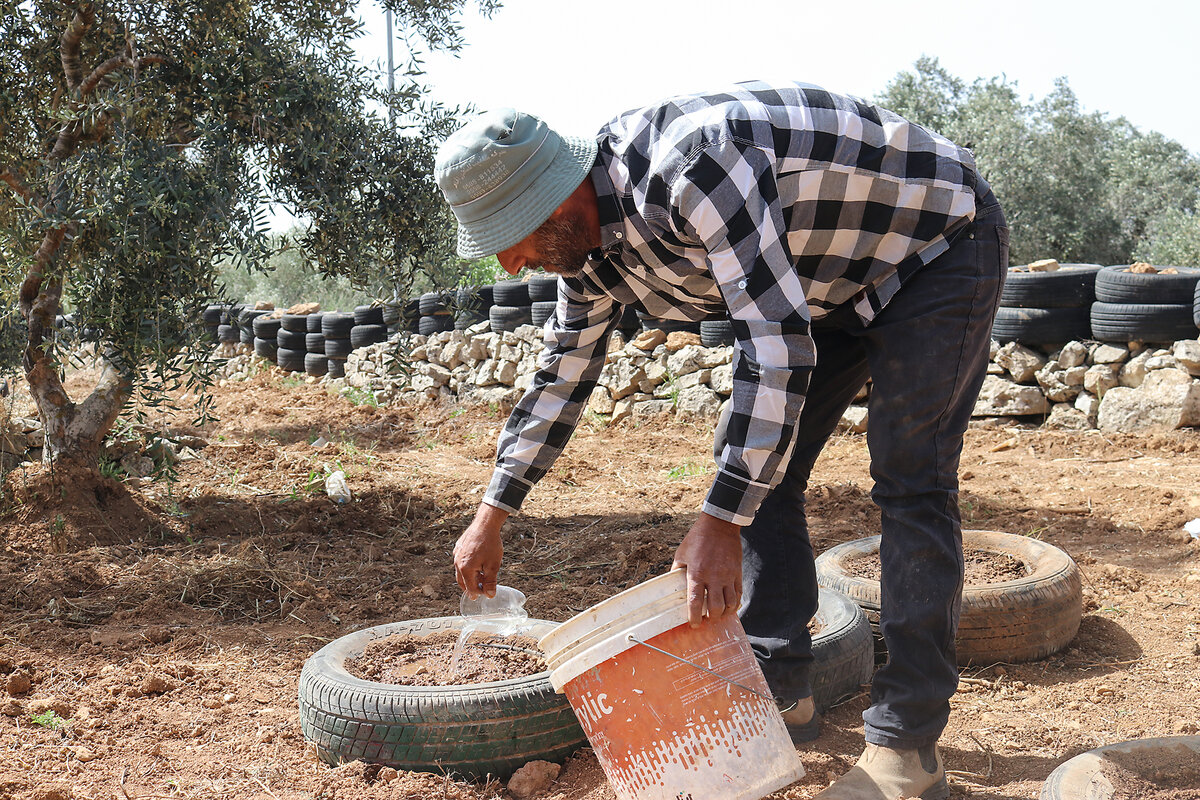
Intimidation, uncertainty
But Farkha’s utopian plans are running up against the reality of settler violence.
Musa al-Wahsh, standing atop the ruins of his dream home, knows it better than most.
Looking for greenery, calm, a fresh start, and a chance for his children to enroll in school, Mr. Wahsh came to Farkha one year ago from Jub Al-Dhib, a herding community near Bethlehem penned in by settlers.
After months of research, he purchased a tranquil acre of land for his home and a dairy farm, downhill from Farkha and surrounded by olive groves and farms, with no building in sight.
At the time, there was only one nearby settler outpost, with one single settler.
To encourage Mr. Wahsh, Farkha’s mayor cleared a road leading to his land and extended electricity lines, in the hope that others would follow suit and settle and farm the village’s outskirts.
Then the settlers came.
As Mr. Wahsh and a contractor were finishing his home’s foundations and walls in December, settlers wearing military uniforms came and ordered him to leave – despite the lands being under complete control of the Palestinian Authority and legally his.
“I told them I legally own this land. I have a permit from my government, the Palestinian Authority, to build here. They have no right to stop me,” Mr. Wahsh says. “Then they fired into the air.”
One settler placed a gun to his contractor’s head and forced him to bulldoze the cement foundations and walls. The settlers then broke his water tanks, flooded stacks of iron, and set fire to a thousand dollars’ worth of wood.
Mr. Wahsh rebuilt, albeit a smaller house a dozen yards or so away from the original site.
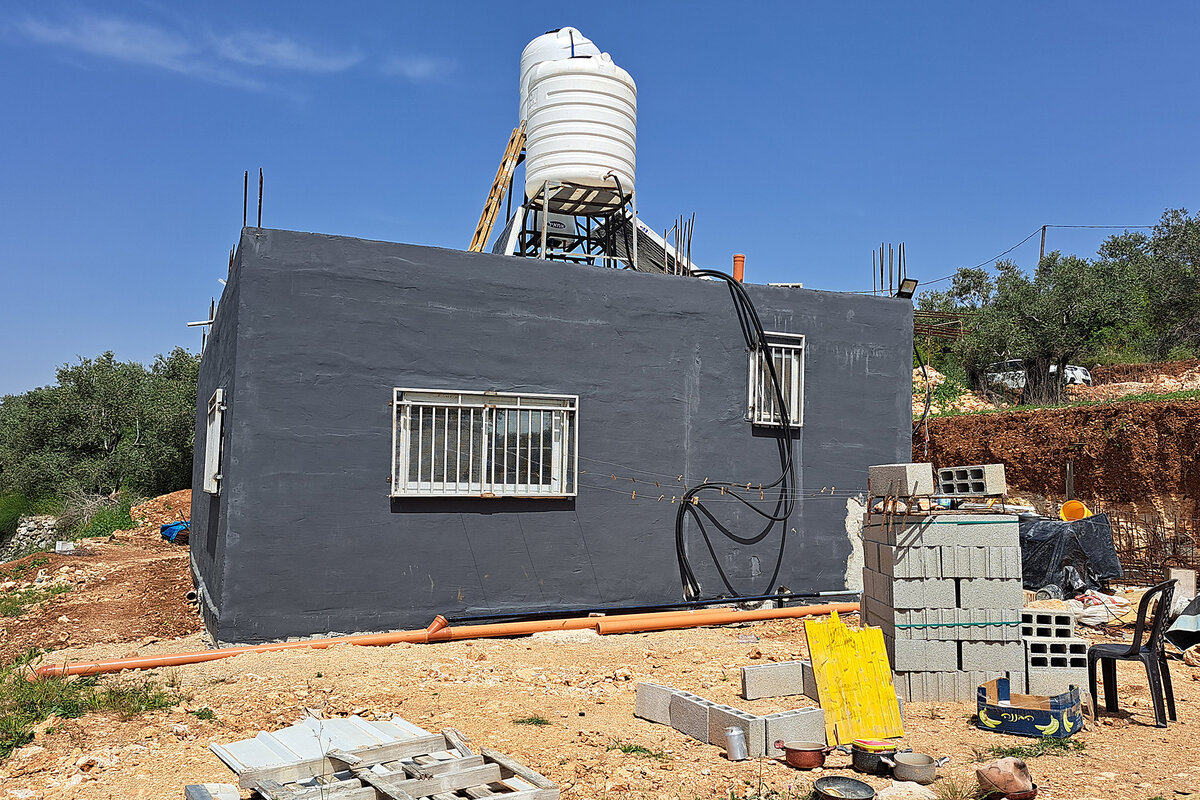
In late March, the settlers returned and threatened him and his children at gunpoint, warning him, “Leave or else.”
“I thought this land would be our sanctuary,” Mr. Wahsh says. “It’s not safe here at all,” he says, holding his 3-year-old daughter. “I’m looking to rent a house up in the village. We can’t stay here.”
Mr. Hammad, the mayor, says ruefully that he wishes Mr. Wahsh “could have held out a little while longer.”
“We would have extended water networks, there would have been neighbors, and he would not have been alone, and not a vulnerable target.”
The mayor is still encouraging “any new project or building” at the same site at the village’s edge.
“If we don’t show our presence and use our land now, we will lose it,” he says.
Yet settlers are visibly getting closer, and multiple settler outposts established near Farkha in the past few years have been legalized by Israel’s far-right government within the last year, according to the settler watchdog Peace Now.
The Farkha municipality and monitoring groups worry that settler construction projects, linked by new settler roads, could soon encircle the village, cutting it off from farmland and most of the West Bank.
A wave of settler attacks last fall prevented many Farkha residents from picking their olives, leading to a record low harvest.
As a result, production of organic olive oil, a Farkha lifeblood, has almost dried up; olive oil is even scarce in the village, forcing villagers to buy from elsewhere.
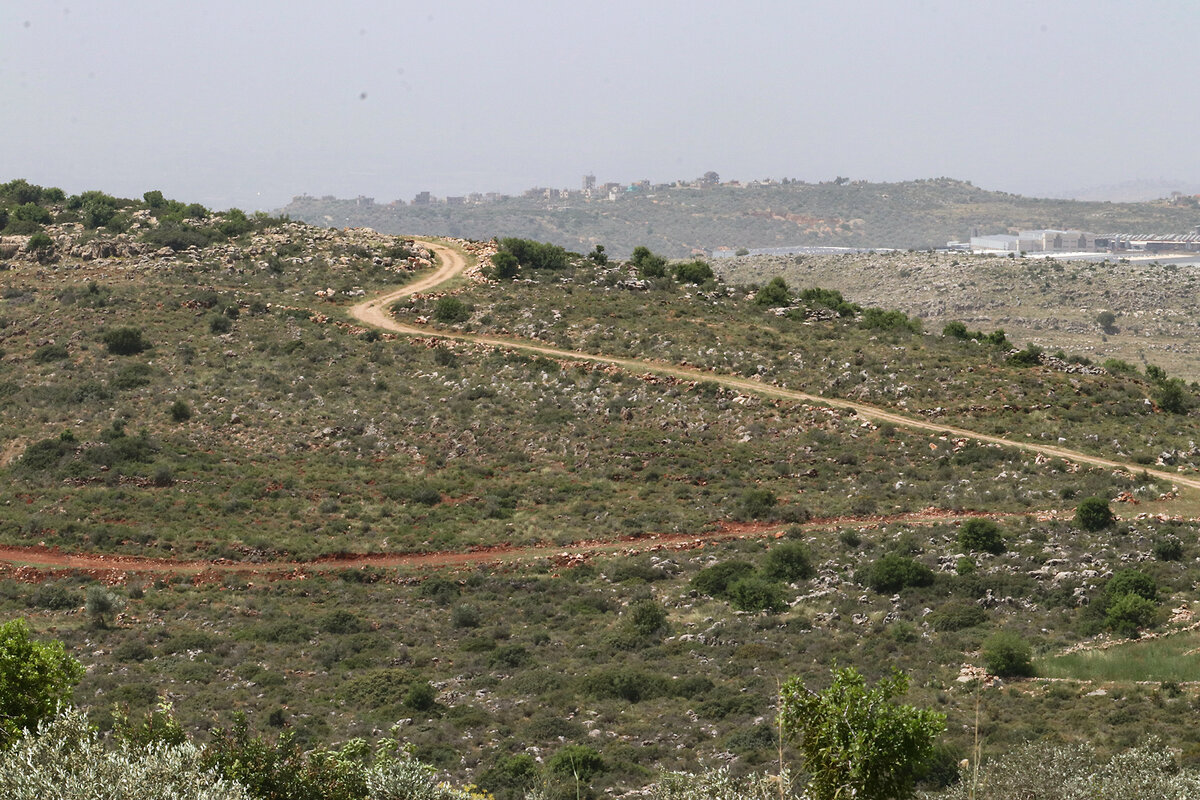
Tired and wary
Mr. Rizaqallah and his wife, Hanin, are visibly tired.
While their garden is flourishing with tomatoes in-season, and bountiful zucchini and eggplant are weeks away, the markets they sell to are shrinking.
“The market is dead. No one is there and no one is buying,” Ms. Rizaqallah says, recently returned from Nablus, once the main hub to sell goods. She has stopped posting photos of her goods on Facebook. “Most people just don’t have the money,” she says.
Due to the depressed West Bank economy, the couple have had better success selling pickled eggplants to the United Arab Emirates than to neighboring villages.
Yet the couple, like the village itself, are still planning for the future. In their backyard, Mr. Rizaqallah has cleared a small plot for citrus trees; the chicken coop is alive with chicks.
The municipality is preparing a nursery for indigenous crops and plants to share across the West Bank, and it is teaching organic farming.
Its home-garden program now has 300 households growing, trading, and selling produce in what it bills as the “home economics of resistance” to occupation.
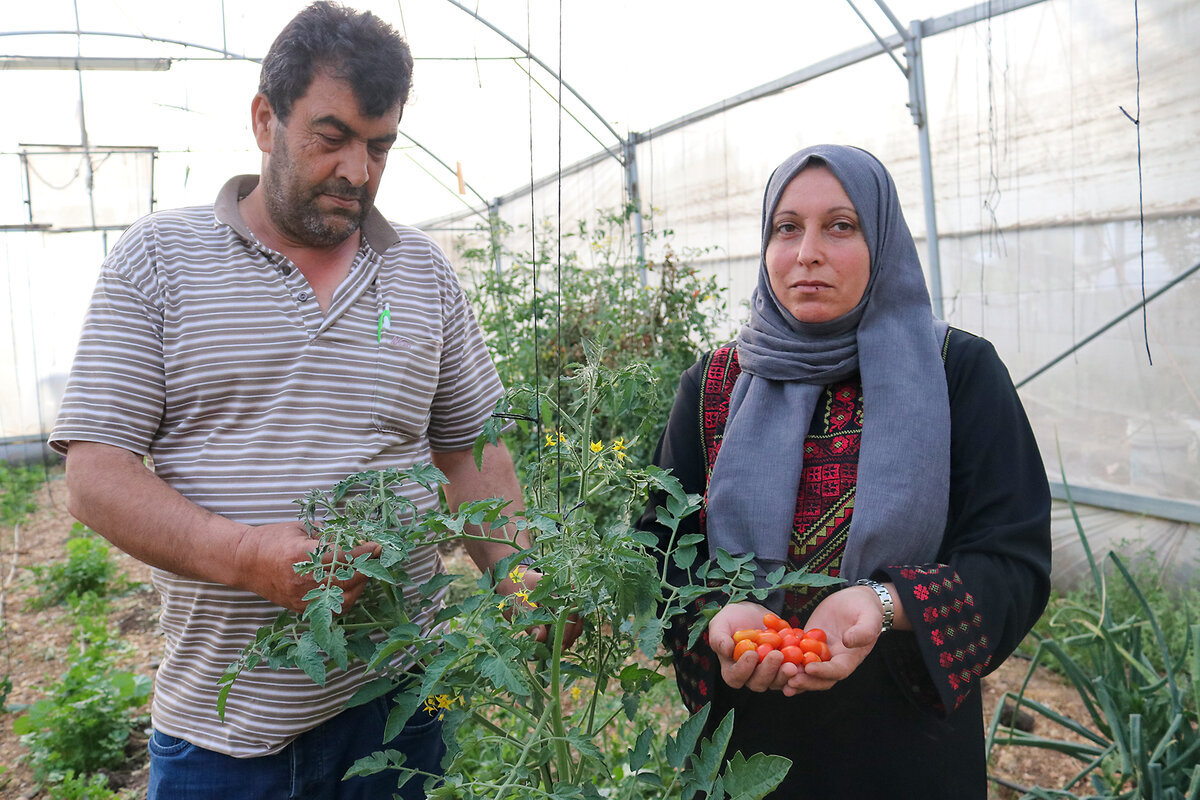
But when Farkha sought Palestinian Authority funding last year for 12 projects ranging from water to agriculture to infrastructure, it did not receive a single reply. The PA did not respond to a request for comment.
There is an unshakable feeling here that the village is on its own.
“We are surviving, but these are all individual initiatives; we are going at it alone,” says Mr. Rizaqallah. “A village cannot stand up to an entire army and settler militias. We need national initiatives. We need unity and support in order to endure.”
“If we were placed under siege, we would have self-sufficiency for 20 or 30 days,” Mr. Rizaqallah says, “but after that we couldn’t last.”
Gazing at the hilltop outpost and the settler road, Mayor Hammad is defiant.
“This is our ancestors’ land and our land,” he says. “We will cling onto our land no matter what it takes.”
Mideast’s Makers of Change
How does a Mideast reporter find, amid recurring conflict, stories loaded with humanity and shared values? Amman-based Taylor Luck, a return guest on this podcast, works to balance credible hope and the cycle of setbacks wrought by hard regional realities. He spoke to host Clay Collins about a generation bent on bringing change – and about what he’s seen while producing datelines from Tunisia to the West Bank.

Podcast
Trust in US elections wavers. Why it’s still higher than you think.
Election denialism remains a hot story. That’s more because of a fraud narrative that’s been stoked than because of anything that evidence shows – or that voters (or many politicians) actually believe. A senior Washington reporter probed the disconnect, and then joined our podcast to explain.

Ever since Bush v. Gore in 2000, voter trust in U.S. elections has followed a zigzag pattern.
Democrats’ trust plunged after Al Gore lost the “long count,” and then surged when Barack Obama won the White House. Donald Trump’s 2016 win sent Republican trust soaring. But his loss in 2020 and attacks on the vote’s legitimacy have driven GOP trust below historic levels.
That sustained unevenness in how the parties poll on trust is different, says Peter Grier, a senior staff writer at the Monitor. “Usually, things bounce back and even out after a few years. That’s not happening right now.”
But election denialism may not run as deep with Republican voters as GOP leaders suggest. “Many of the elite don’t believe it either,” Peter adds. “They go along with it because they’re afraid of Mr. Trump’s ability to sway votes.”
Polls signal that large majorities believe that their own vote will be fairly counted, but that those of voters in other places may not be. Transparency can help. Some secretaries of state are authorizing tours of their election system to showcase protections against fraud.
When they do, Peter notes, they find it to be a powerful way to instill trust in the electoral process. – Gail Chaddock and Jingnan Peng
Find story links and a transcript here.
In Voting We Trust?

LeVar Burton soars in ‘Reading Rainbow’ documentary
“Reading Rainbow” remains a touchstone for generations of American children. But as a new documentary shows, it – and host LeVar Burton – means so much more than nostalgia.

- Quick Read
- Deep Read ( 4 Min. )
“Reading Rainbow,” which ran on PBS from 1983 until 2006, is just that – a prism that showed up after the proverbial rain. It was diverse, a celebration of humanity, regardless of race or age. It gave young people the freedom to speak during a time when children were encouraged to be “seen and not heard.”
A new documentary, “Butterfly in the Sky,” is a triumph rather than a requiem. Aside from its praise of programming that advocates for literacy, and host LeVar Burton himself, there’s a sense of humanity that perseveres and goes beyond the warmness of nostalgia. Maybe it’s watching the smiling kids who became loving adults. Or it could be watching the series’ founders speak about familial ties that went beyond educational rhetoric.
It reminded me of my own family, my community – all of the folks who believed in me since I was old enough to write my own book reports.
LeVar Burton soars in ‘Reading Rainbow’ documentary

“Butterfly In the Sky,” a documentary about the iconic “Reading Rainbow” TV series, opens with an elegance befitting that kaleidoscopic feat of nature.
LeVar Burton, the host of “Reading Rainbow,” and my friend and yours, is holding a copy of “Amazing Grace” by Mary Hoffman. It is fitting, as Burton sits majestically in the middle of a library, his graying goatee pristinely trimmed. He is a Black man, a fact that doesn’t go unnoticed or underappreciated during this roughly 90-minute blast from the past.
“For the kids like me watching LeVar, for those of us who look like me, it mattered that LeVar was a Black man,” offered Jason Reynolds, a young adult author whose commentary stole many scenes.
Both of my parents encouraged me to read, but it was my dad whom I remember standing over me as I pored over the same newspapers he read. When my parents went to their favorite soul food restaurant, the servers got a kick out of the 3-year-old who read the menu word for word. Let my parents tell it, that gift picked up the tab a few times.
“Reading Rainbow,” which ran on PBS from 1983 until 2006, is just that – a prism that showed up after the proverbial rain. It was diverse, a celebration of humanity, regardless of race or age. It gave young people the freedom to speak during a time when children were encouraged to be “seen and not heard.”
Burton remains the perfect conduit for this journey – a wise sage whose salt-and-pepper hair is the visualization of a beautiful juxtaposition. He displays the wisdom that comes with experience and combines it with the freshness and relatability of a man who harbors the heart of a child. He is Afrofuturism and “the old way” all at the same time. If not for his graying hair, Burton today and the man who shows up in the flashbacks of “Reading Rainbow” episodes would be virtually indistinguishable.
His various incarnations are the stuff of documentaries as well. My dad had a small paperback version of “Roots,” which was translated into a TV miniseries that broke viewing records. Burton became a household name as Kunta Kinte. As a nearsighted kid who grew up during a less forgiving time of “Family Matters” and Steve Urkel, I longed to trade my glasses in for the cool VISOR that Burton wore as Geordi La Forge on “Star Trek: The Next Generation.”
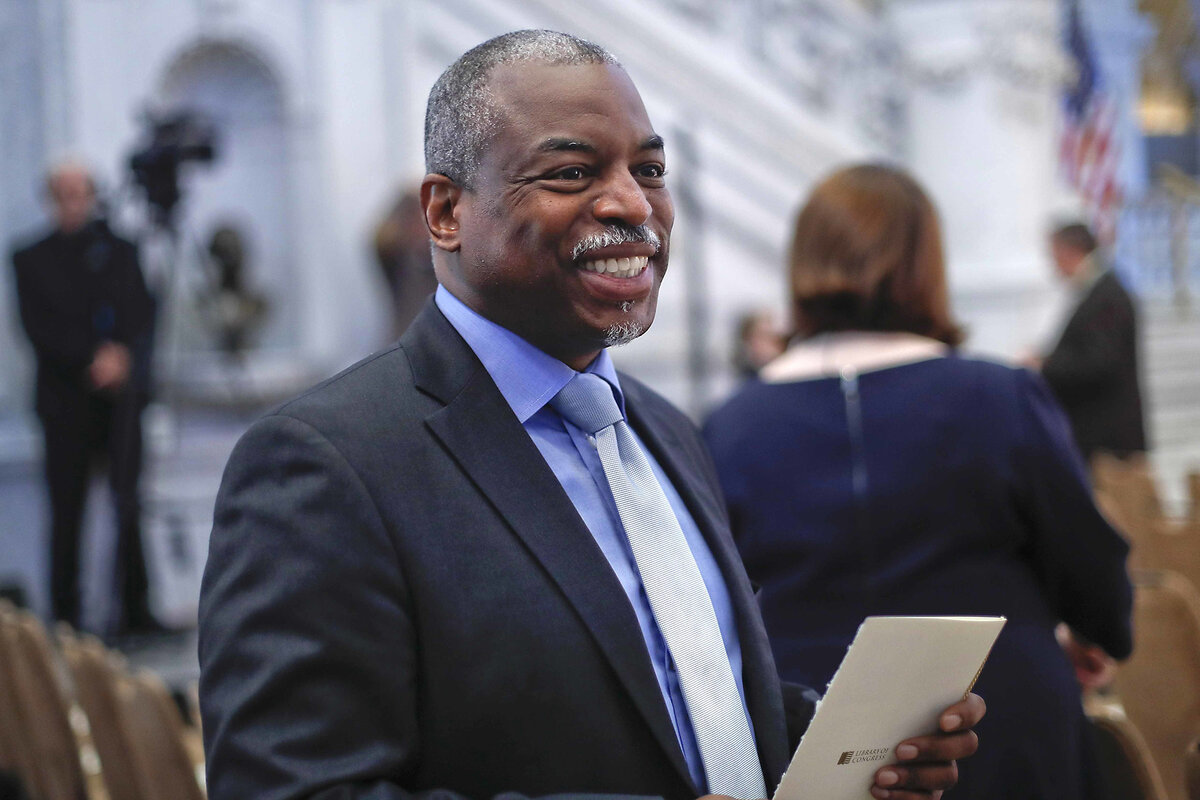
And yet, Burton is no mere symbol. He is an actor and activist, his defiance apparent in everything from how he wore his facial hair, to his rebuke of legislators who sought to take federal funding from public TV shows like “Reading Rainbow.”
The documentary, on which Whoopi Goldberg served as executive producer, describes how Burton pushed back against producers who were splitting hairs over how he wore his mustache. They asked him to shave it off. He refused. The idea from the brass was to foster uniformity. Burton prioritized his authenticity.
“I’ve been told my whole life by society that there was something intrinsically wrong with me, or undeserving of me, because of the color of my skin,” he said. “And I think that made me especially recalcitrant to give in.”
I think of Darryl George, the young man in Texas who is still being punished and discriminated against at school for how he wishes to wear his hair. Even legislation such as the CROWN Act, designed to protect Black people from having such matters policed, falls woefully short.
This, among other reasons, was why it was so important for Burton to testify in defense of “Reading Rainbow,” and by extension, all of us. It’s easy to read that as protecting Black men, but no, I mean all of us. This is part of the mosaic which makes up civil rights: Black people putting themselves on the stand to secure the privileges of all.
Ultimately, the documentary is more of a triumph than a requiem. Aside from its praise of programming that advocates for literacy and of Burton himself, there’s a sense of humanity that perseveres and goes beyond the warmness of nostalgia. Maybe it’s watching the smiling kids who became loving adults. Or it could be watching the series’ founders speak about familial ties that went beyond educational rhetoric.
It reminded me of my own family, my community – all of the folks who believed in me since I was old enough to write my own book reports, or read a menu. Reynolds spoke to that beautifully as well:
“[Burton] reading is awesome. But a lot of us read. So, for me, turning him into a positive figure simply because he was promoting reading is dangerous because it assumes there weren’t a lot of us reading,” he said. “Or there weren’t a lot of Black teachers who were doing the same thing, Black librarians … Black parents, Black scholars, Black coaches and counselors, that all existed.
“Really, what [Burton] was doing was saying, Yeah, yeah, yeah, we’re him, too. So now what?”
“Butterfly in the Sky” debuts on Netflix on May 24, after a brief theatrical run. It is rated TV-G.
Other headline stories we’re watching
(Get live updates throughout the day.)The Monitor's View
Teachable moment for African schools
- Quick Read
- Deep Read ( 2 Min. )
-
By the Monitor's Editorial Board
Every year, wealthy nations provide billions of dollars to poorer countries to build better services and infrastructure. Less that 2% of that money goes straight to the communities it is supposed to benefit. Now more donors want to increase that direct funding to ensure that projects better reflect local priorities and improve accountability. Two new programs in Rwanda and Sierra Leone provide good examples.
Launched at the Education World Forum in London this week, the new approach is targeted at providing better access to early education for rural girls and children with disabilities. The big experiment is this: The roughly $30 million in new donor money will be conditioned on achieving specific results, rather than fueling the usual practice of largely unaccountable spending based on good intentions.
A local community will need to develop its own strategy, tap its own resources (such as local businesses), and achieve its education goals. If it does, it will be reimbursed. The results must be independently confirmed.
This requires a high level of honesty and selflessness, advocates say, enabling more trust between foreign funders and local actors.
Teachable moment for African schools
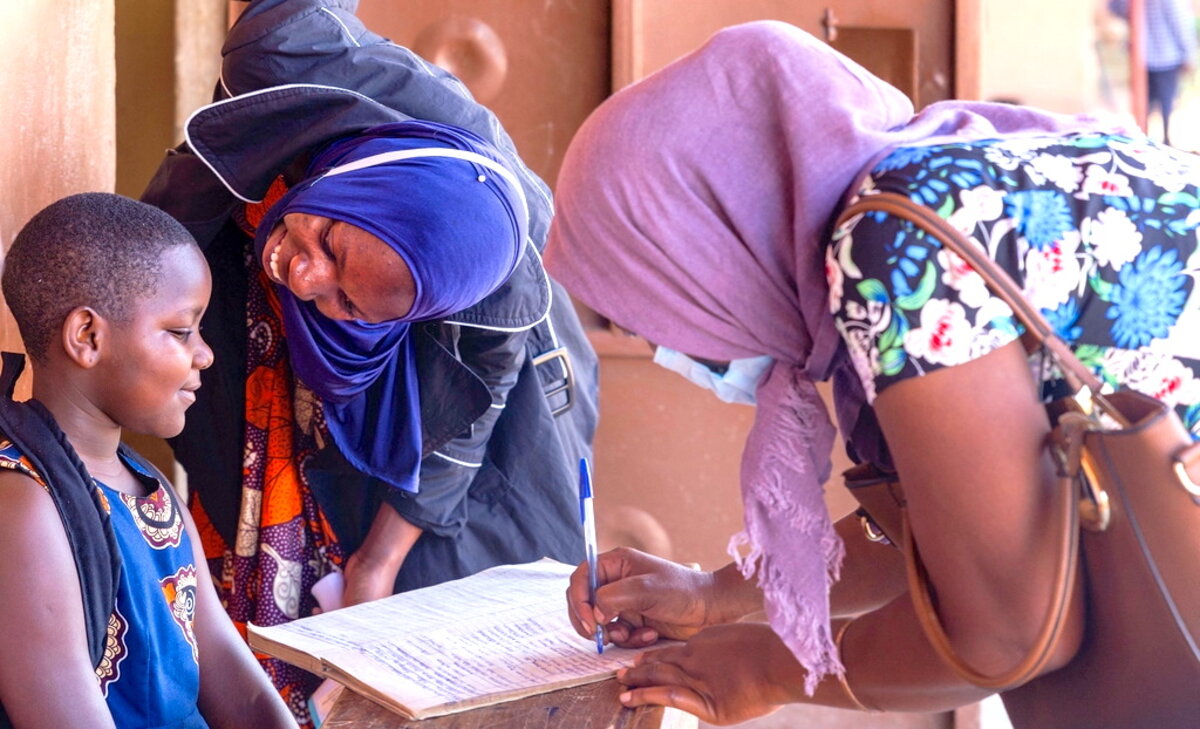
Every year, wealthy nations provide billions of dollars to poorer countries to build better services and infrastructure. Less that 2% of that money goes straight to the communities it is supposed to benefit, according to the British-based tracking organization Development Initiatives Poverty Research. Now more donors want to increase that direct funding to ensure that projects better reflect local priorities and improve accountability. Two new programs in Rwanda and Sierra Leone provide good examples.
Launched at the Education World Forum in London this week, the new approach is targeted at providing better access to early education for rural girls and children with disabilities. Both groups were particularly set back by the recent pandemic. The big experiment is this: The roughly $30 million in new donor money will be conditioned on achieving specific results, rather than fueling the usual practice of largely unaccountable spending based on good intentions.
A local community will need to develop its own strategy, tap its own resources (such as local businesses), and achieve its education goals. If it does, it will be reimbursed. The results must be independently confirmed.
This requires a high level of honesty and selflessness, advocates say, enabling more trust between foreign funders and local actors. “Accountability to the program participants is the most critical part of any results-based funding project,” noted a Center for Effective Philanthropy blog post.
This new model of tying aid to outcomes is partly driven by a strain on international resources as a result of wars and catastrophes. It might even be used for postwar reconstruction in Ukraine as a way to curb corruption.
A year ago, the governments of Ghana and Britain partnered to launch the world’s largest such project. It set aside $30 million to spur communities accounting for 600 primary schools in the West African country to promote teacher excellence and draw back 70,000 primary school students whose educations were disrupted by the pandemic.
The new initiatives in Rwanda and Sierra Leone pool funding from the countries’ governments, the Lego Foundation, and the Education Outcomes Fund. They mark, as Ghana’s education minister, Yaw Osei Adutwum, described the project in his country, a “watershed moment” in the way international partners help poorer countries serve their citizens better through local accountability.

A Christian Science Perspective
Each weekday, the Monitor includes one clearly labeled religious article offering spiritual insight on contemporary issues, including the news. The publication – in its various forms – is produced for anyone who cares about the progress of the human endeavor around the world and seeks news reported with compassion, intelligence, and an essentially constructive lens. For many, that caring has religious roots. For many, it does not. The Monitor has always embraced both audiences. The Monitor is owned by a church – The First Church of Christ, Scientist, in Boston – whose founder was concerned with both the state of the world and the quality of available news.
Glimpse eternal Life and find freedom from grief
- Quick Read
- Read or Listen ( 4 Min. )
-
By Donald Carey
As we learn about the eternal nature of God and His creation, we’re empowered to challenge limited views of life and experience profound comfort.
Glimpse eternal Life and find freedom from grief
One of the greater challenges facing humankind is the belief that life is finite. Daily news reports usually include incidents that involve loss of human life. In our own lives we might face the loss of a loved one or interact with someone who has experienced such a loss. The range of emotions may include shock, grief, or loneliness.
The problem of death – and the solution to this problem – is best understood through the teachings of Christ Jesus. Not only did Jesus raise others from the grave, but he also overcame it for himself. Before his crucifixion, he explained to his disciples that three days after it occurred he would be resurrected.
Based on accounts in the Gospel of John, it seems his disciples didn’t understand what that meant, for following his crucifixion they returned to their former occupations. And Mary Magdalene, when she returned to the sepulchre and saw Jesus, did not at first recognize him.
But when his disciples did recognize Jesus, they caught a glimpse of the uninterrupted continuity of Life, God, and they were forever changed. The proof that death could be overcome through the power of God gave them a deeper perception of the reality of life in Spirit.
Speaking of Jesus’ resurrection, Mary Baker Eddy writes in the Christian Science textbook, “Science and Health with Key to the Scriptures,” “The magnitude of Jesus’ work, his material disappearance before their eyes and his reappearance, all enabled the disciples to understand what Jesus had said. Heretofore they had only believed; now they understood” (p. 43).
The fundamental truth underlying Jesus’ works is that Spirit, not matter, is the only power. In the first chapter of the Bible it is recorded that man is made in God’s image (see Genesis 1:26). As God is Spirit, the real man is spiritual, not imprisoned in a mortal mind and material body.
My wife and I consistently relied on Christian Science as an ever-present help in life. When we’d face challenges in business, our health, or in our family, regardless of whether it was a minor or major issue, we found that prayer and listening to God guided us successfully.
So when my wife passed on, it was our study of the reality of God and man that came to thought. I saw that neither her life nor mine had ever truly existed in matter, and this healed me of grief and a feeling of loss. I was fully confident that my wife was continuing on.
The belief that man exists in matter, living and dying in the body, is the mistaken basis for all beliefs in death, grief, sorrow, and loss. The second chapter of Genesis declares man to be made from dust. But as Jesus showed us, this “dust” man can be proved to be a false concept, as it is the exact opposite of the man revealed in the previous chapter as made in God’s likeness. The spiritual understanding of the falsity of this second account frees us from the bondage it imposes.
It is in human consciousness that the seeming reality of life in matter needs to be addressed. The material senses argue that life is a mixture of spirituality and materiality. But a glimpse of Christ, Truth, begins to reshape our views of existence, bringing us into a full recognition that God is the sole creator of a marvelous spiritual universe, including man.
Where God’s law of harmony operates – which is everywhere – there is only good, God, and His spiritual creation. Through Christ, Truth, stubborn material beliefs disappear from human consciousness, and that which before seemed intangible – spiritual substance – appears. Then we can, like the Apostle Paul, “look not at the things which are seen, but at the things which are not seen: for the things which are seen are temporal; but the things which are not seen are eternal” (II Corinthians 4:18).
This understanding brings freedom from what can often feel like a heavy weight of grief when we lose someone close to us. As a result of my healing of grief after the passing of my wife, I have been able to share with others what I’ve learned. This has resulted in the lessening of their sense of grief and loss, and they have expressed gratitude for this help.
While it takes spiritual growth and persistence, we can begin at once to understand to some degree the indestructible nature of Life, God, and to rid ourselves of the belief that life ends in death.
Adapted from an article published in the July 16, 2018, issue of the Christian Science Sentinel.

Viewfinder
Diploma, done!
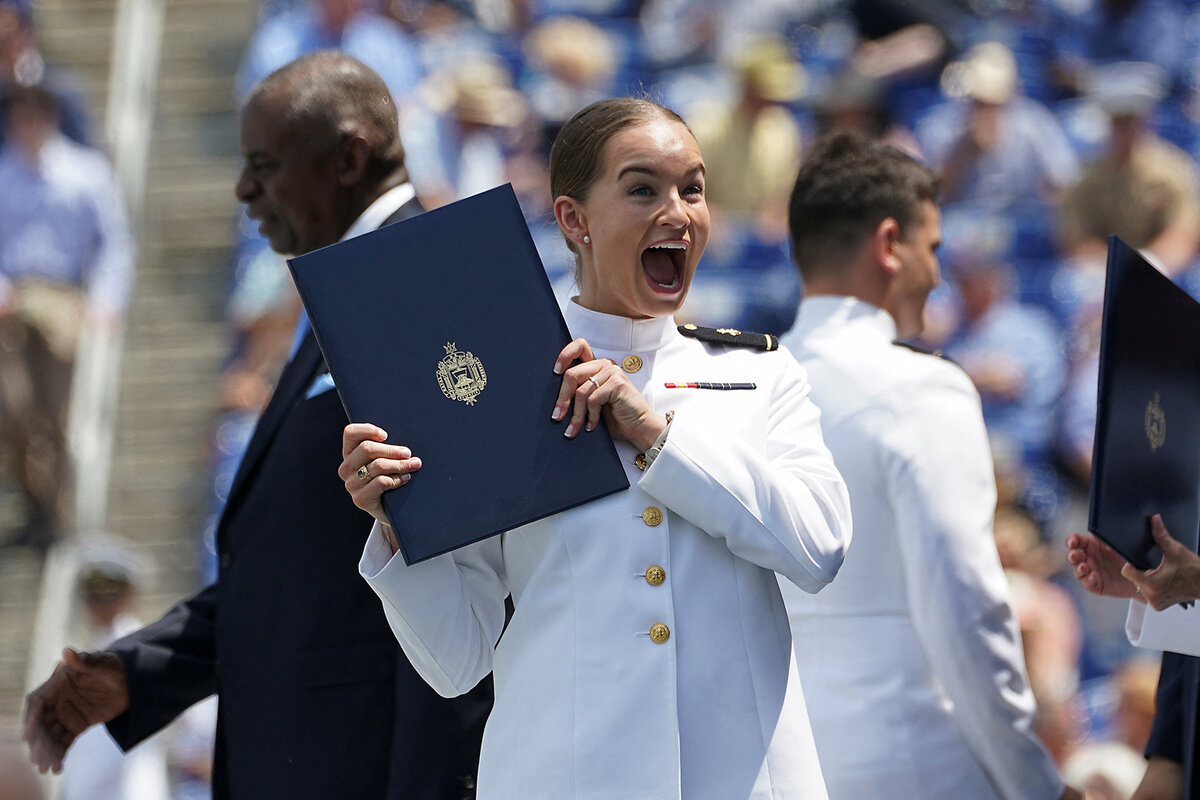
A look ahead
Thank you for joining us today. As you head into your weekend, please remember that Monday is the Memorial Day holiday in the United States, so there will be no Daily. Your next edition will arrive Tuesday, May 28.


